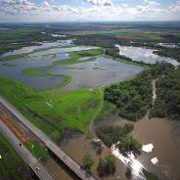Here’s a shocker: Yes, action is necessary on the San Francisco Bay Delta

State and federal authorities provided an update Wednesday on the Bay Delta Conservation Plan (BDCP), which is tasked with restoring the damaged ecosystems of the Sacramento-San Joaquin Delta and safeguarding California’s water supply.
“The 25 million Californians who rely on the Delta for clean drinking water are at severe risk,” said Secretary of the Interior Ken Salazar, on a call with reporters.
It’s well established that the current system of water delivery that shuttles water from north to south through the Delta causes damage to wetlands and threatens native species, as well as leaving the water supply vulnerable to earthquakes and pollution.
“There is now a clear consensus that the status quo is unsustainable,” said Senator Dianne Feinstein, in a written statement.
The report released Wednesday focuses on three key elements, which Deputy Secretary David Hayes outlined on the call:
1. Improve water quality and restore the ecosystems
2. Rather than just pumping water through the Delta, water should also be moved around the Delta through an underground tunnel
3. Create a monitoring and adaptive management plan for the Delta, that would allow for flexibility
The 92-page “highlights” report is not a final plan, nor even a draft plan, which is not expected until next year. Instead it is a “status report on the condition of the BDCP” and a “transition document” from the Schwarzenegger-to-Brown administrations, said Lester Snow, head of the California Natural Resources Agency.
Despite its preliminary nature, however, the report has sparked criticism from environmental groups such as the Environmental Defense Fund, The Bay Institute, and the Natural Resources Defense Council, which cite its lack of endangered species protections and a water conservation strategy, among other concerns.
“This plan is not ready for prime time,” said Gary Bobker, Program Director at the Bay Institute. “Whether it’s the quality of the analysis, or paying attention to the best available scientific information, or facing up to some hard policy choices about the future, the plan simply does not pass the laugh test.”
Felicity Barringer has more on the BDCP and its recent history in an article for The New York Times.
3 thoughts on “Californians Who Rely on Delta at “Severe Risk””
Comments are closed.

Yesterday’s announcement by State and federal officials about moving forward with the BDCP is welcome news for most California water users. It would have been unanimous except for the expected response from certain environmental groups who continue to play a delaying game against restoring reliable water supplies and a restored Delta ecosystem. Their immediate objection to proposed tunnels, which would provide additional safeguards for fish and be paid for by water users, is unreasonable and only results in continued delays and increased costs.
Mike Wade
California Farm Water Coalition
The science is clear that the Delta needs higher water flows to maintain the environment. This plan states that it will allow increased water flows from the rivers. The tunnel design is sized for four times the flow mentioned in the report and plan. The Devil is in the details!
Tim and others,
We deleted a portion of the comment above because it violated KQED’s Community Discussion Guidelines, which you can access here: http://www.kqed.org/about/help/discuss.jsp
We welcome a diversity of opinions and thoughtful dialogue here at the Climate Watch blog, but we cannot accept personal attacks or disrespectful comments. We want this to be a space for productive discussion, and we hope you do, too.
Gretchen